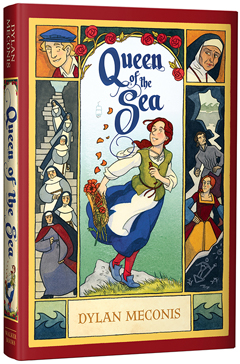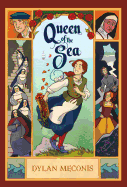Queen of the Sea
by Dylan Meconis
In this spirited graphic novel, Dylan Meconis (The Long Con) imagines an alternate history based on a dangerous time in the life of Queen Elizabeth l, told from the point of view of an orphan girl with a secret past. Altering events and names enough to create her own world, Meconis nevertheless preserves the historical detail of the Tudor period and the wild, windswept beauty of a tiny British isle.
"I wasn't born on the island," Margaret tells readers, but she has lived on the tiny, rocky speck as long as she can remember. Raised at the convent of St. Elysia, her only clues to her past come from the nuns and servants who have charge of her. Unfortunately, they give only surface details--no one, not even the wise and benevolent Prioress Sister Agnes, will tell her who her parents were. Margaret's best guess is that she came from the much larger island of Albion, Meconis's version of historic England. Although content in her cloistered upbringing, Margaret feels lonely as the only child on the island--for youthful companions, she has only religious statuary and a portrait of Princess Eleanor, second daughter of King Edmund. Her life changes for the better when she meets William MacCormick, a laird's son about her age, who comes to live on the island with his widowed mother, Lady Cameron. Though William's plumed hat, fur-trimmed coat and arrogant words make a poor first impression on Margaret, three years later "it was as if William had always lived on the island" and the two tweens are inseparable.
However, when circumstances conspire to send William to join his male relations in the prison of Highwall Keep on Albion, Margaret learns that her beloved island is also a detention camp. Rather than devout women called to serve their saint, the sisters are noblewomen who committed real or perceived crimes against the king. They are forced to live at the convent, where many choose to take holy orders. Like the sisters, Margaret cannot leave without committing treason, though Sister Agnes refuses to explain why the king imprisoned her as a baby.
When civil war breaks out on Albion following Edmund's death, Princess Catherine seizes the throne and sentences her sister to imprisonment. On a rain-drenched night, Princess Eleanor and her imperious chaperone arrive at the island. Cross and demanding, the princess proves a challenge for kindhearted, plainspoken Margaret. Cagey Eleanor's affections run hot and cold, but when Margaret learns she spent time at Highwall Keep, she sees in Eleanor a means of learning William's fate. An uneasy alliance forms between the girls, but Eleanor's friendship carries a high price for Margaret, who soon finds herself drawn into a dangerous plot and confronted with the truth of her own origins.
Readers age 10 and up are sure to fall in love with loyal, clever Margaret, whose wholesome appeal remains refreshing throughout. In Eleanor, Meconis flawlessly balances the facets of Elizabeth I's complex personality: she is by turns brilliant, entitled, mature and imperious, each mood telegraphed by pitch-perfect facial expressions. Although often perplexed by this mercurial new presence in her life, Margaret's buoyancy and grounded perspective make her more than able to stand up to Eleanor; their uneasy relationship with its implied power imbalance drives the plot as unsophisticated Margaret finds herself drowning in political intrigue.
Meconis's hybrid work uses a traditional graphic novel format featuring hand-drawn comic panels and lush, full-page spreads with Margaret's journal-like text passages. Perhaps mimicking the confines of Margaret's convent life, the panels are neat and ordered, each packed with expressive, lively illustrations, while the full-page spreads take advantage of blank space, giving Margaret room to break the rigidity of her borders. These digressions are accompanied by a purposely naïve illustrative style, with Merconis's ink-and-watercolor drawings matching her chatty, informal tone. Her illustrations feature feather-soft green, terracotta and blue-gray, keeping the nearness of rock and sea a constant presence and bringing the the island to vivid life. Although the characters acknowledge King Edmund instead of Henry VIII and pray to the Sorrowful Son instead of Jesus Christ, Meconis keeps historical pastimes and daily lives true to the time period. Readers will learn the table signs the nuns use during their silent meals and find traces of the "Old People" who left barrows and standing stones on the island. In one humorous instance, a frustrated Margaret learns embroidery at Lady Cameron's side, supply lists and stitch names spooling above her harried face as peridot leaves, burgundy blooms and goldenrod stars (actual embroidery Meconis scanned into her art) dance around her serene tutor. Through these rich asides, classroom and book club extension activities practically suggest themselves (Meconis even includes a "terrible gruel" recipe for an authentic taste of commoner sustenance).
This adventurous historical fiction romp could well be this generation's successor to Karen Cushman's Catherine, Called Birdie, but its deep dive into the complicated dynamics of friendship should also make it a surefire hit with fans of Raina Telgemeier or Shannon Hale and LeUyen Pham's Real Friends. Meconis's threaded needle piercing the last page suggests she might return and embroider further chapters of Margaret's adventures. Graceful and passionate, Queen of the Sea is destined to become queen of hearts. --Jaclyn Fulwood








